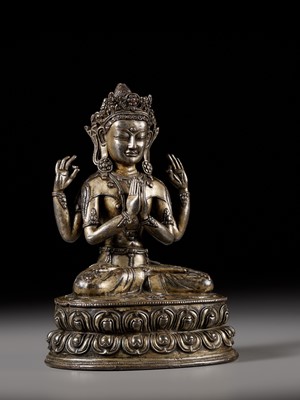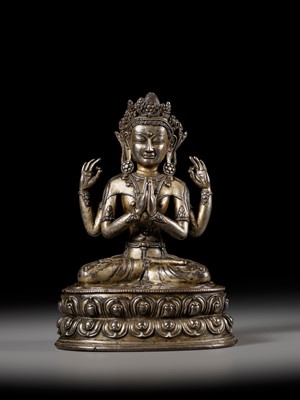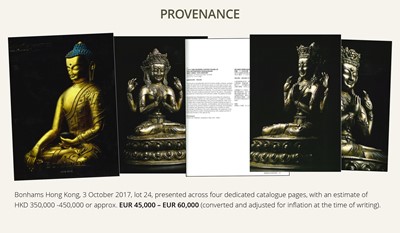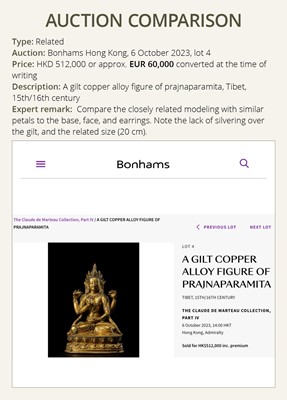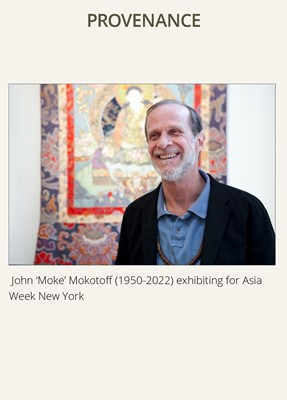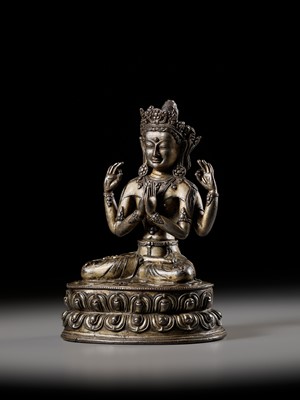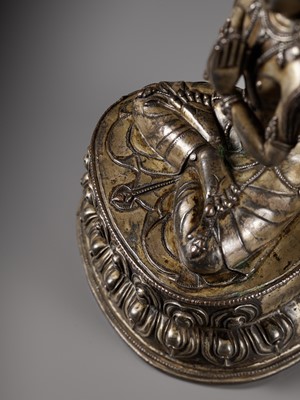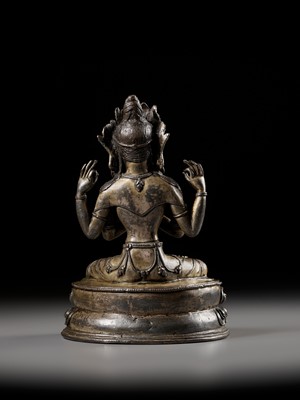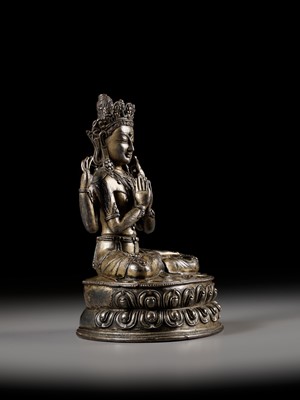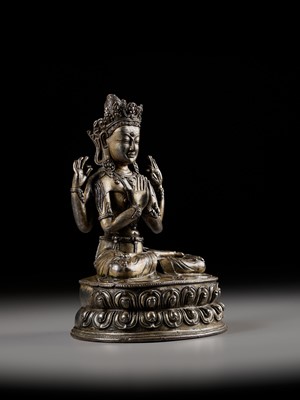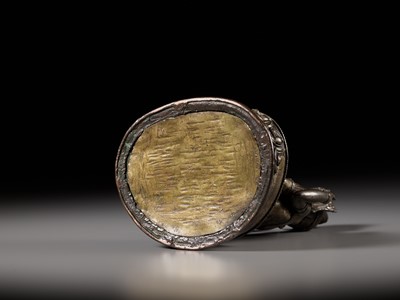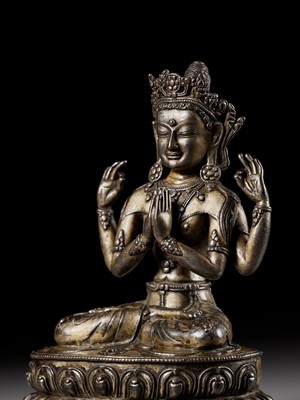11th Apr, 2024 11:00
TWO-DAY AUCTION: Fine Asian Art, Buddhism and Hinduism
14
A RARE GILT AND SILVERED COPPER FIGURE OF AVALOKITESHVARA SHADAKSHARI, STYLE OF SONAM GYALTSEN ATELIER, 15TH-16TH CENTURY
Sold for €13,000
including Buyer's Premium
Expert’s note: The present bronze is exceptionally rare for its three metallic surfaces, revealed under the wear from its devotional career: an outer layer of gold, over a layer of silver, over a rich copper base that fluctuates between deep chocolate brown and pinkish flashpoints, where the surface has been most rubbed and reactive to hand oils. It is a triumph of metal finishing in Tibet. As each sculpture produces merit for the patron, the greater the expense of adorning it with precious metals, the greater the yield.
Central Tibet. Cast as the four-armed manifestation of Avalokiteshvara, seated in dhyanasana on a double lotus base with beaded rims, the primary arms in anjali mudra at the chest, the other arms raised in vitarka mudra, the body richly adorned in beaded jewelry, a sash covering the shoulders, the squared face with heavy-lidded eyes below near horizontal brows centered by a spiral urn. The head surmounted by a foliate tiara with the pendulous ears suspending circular earrings.
Provenance: The Moke Mokotoff Collection, New York, by repute acquired in the 1990s. Bonhams Hong Kong, 3 October 2017, lot 24, presented across four dedicated catalogue pages, with an estimate of HKD 350,000 -450,000 or approx. EUR 45,000 – EUR 60,000 (converted and adjusted for inflation at the time of writing). John ‘Moke’ Mokotoff (1950-2022) was a devoted Buddhist practitioner, passionate collector, and esteemed dealer of Asian art. After studying expressive art and photography in school, he moved to New York, where he began to deal in the nascent market for Chinese, Indian, and Himalayan art. In 1980, Moke opened his first gallery, Mokotoff Asian Arts, and actively sold important works to some of the most prominent collections in New York and globally, including the Metropolitan Museum of Art and the Rubin Museum of Art. Revered for his knowledge of Chinese and Indian textiles, Moke was also a compassionate teacher and lifelong patron of Buddhist monasteries and nunneries.
Condition: Very good condition with old wear, few nicks, light scratches, and casting flaws. The base possibly resealed.
Weight: 1,3 kg
Dimensions: Height 18.4 cm
This bronze bears the hallmarks of a recently identified master sculptor, Sonam Gyaltsen, such as the squared face with horizontal eyebrows and spiral urna, the distinct shape of the lotus petals on the base, the slender physiognomy, and the sash covering his shoulders. Sonam Gyaltsen lived during the first half of the 15th century in Shigatse, South-central Tibet, where he was patronized in 1430 by the Sakya school and the Rinpungpa dynasty centered in Shigatse.
Avalokiteshvara Shadakshari in this form personifies the ubiquitous Tibetan Buddhist mantra 'om mani padme hum', thought to contain the essence of the Bodhisattva, the Lord of Compassion. Here, he is modeled with a sweet face informed by Chinese imperial bronzes of the 15th century. He is peaceful, contemplative, and otherworldly as he looks beyond his primary hands in a gesture of entreaty and salutation. His coppery hair descends in long tresses over a mantle on which rest pendant necklaces in the round.
Auction result comparison:
Type: Related
Auction: Bonhams Hong Kong, 6 October 2023, lot 4
Price: HKD 512,000 or approx. EUR 60,000 converted at the time of writing
Description: A gilt copper alloy figure of prajnaparamita, Tibet, 15th/16th century
Expert remark: Compare the closely related modeling with similar petals to the base, face, and earrings. Note the lack of silvering over the gilt, and the related size (20 cm).
Expert’s note: The present bronze is exceptionally rare for its three metallic surfaces, revealed under the wear from its devotional career: an outer layer of gold, over a layer of silver, over a rich copper base that fluctuates between deep chocolate brown and pinkish flashpoints, where the surface has been most rubbed and reactive to hand oils. It is a triumph of metal finishing in Tibet. As each sculpture produces merit for the patron, the greater the expense of adorning it with precious metals, the greater the yield.
Central Tibet. Cast as the four-armed manifestation of Avalokiteshvara, seated in dhyanasana on a double lotus base with beaded rims, the primary arms in anjali mudra at the chest, the other arms raised in vitarka mudra, the body richly adorned in beaded jewelry, a sash covering the shoulders, the squared face with heavy-lidded eyes below near horizontal brows centered by a spiral urn. The head surmounted by a foliate tiara with the pendulous ears suspending circular earrings.
Provenance: The Moke Mokotoff Collection, New York, by repute acquired in the 1990s. Bonhams Hong Kong, 3 October 2017, lot 24, presented across four dedicated catalogue pages, with an estimate of HKD 350,000 -450,000 or approx. EUR 45,000 – EUR 60,000 (converted and adjusted for inflation at the time of writing). John ‘Moke’ Mokotoff (1950-2022) was a devoted Buddhist practitioner, passionate collector, and esteemed dealer of Asian art. After studying expressive art and photography in school, he moved to New York, where he began to deal in the nascent market for Chinese, Indian, and Himalayan art. In 1980, Moke opened his first gallery, Mokotoff Asian Arts, and actively sold important works to some of the most prominent collections in New York and globally, including the Metropolitan Museum of Art and the Rubin Museum of Art. Revered for his knowledge of Chinese and Indian textiles, Moke was also a compassionate teacher and lifelong patron of Buddhist monasteries and nunneries.
Condition: Very good condition with old wear, few nicks, light scratches, and casting flaws. The base possibly resealed.
Weight: 1,3 kg
Dimensions: Height 18.4 cm
This bronze bears the hallmarks of a recently identified master sculptor, Sonam Gyaltsen, such as the squared face with horizontal eyebrows and spiral urna, the distinct shape of the lotus petals on the base, the slender physiognomy, and the sash covering his shoulders. Sonam Gyaltsen lived during the first half of the 15th century in Shigatse, South-central Tibet, where he was patronized in 1430 by the Sakya school and the Rinpungpa dynasty centered in Shigatse.
Avalokiteshvara Shadakshari in this form personifies the ubiquitous Tibetan Buddhist mantra 'om mani padme hum', thought to contain the essence of the Bodhisattva, the Lord of Compassion. Here, he is modeled with a sweet face informed by Chinese imperial bronzes of the 15th century. He is peaceful, contemplative, and otherworldly as he looks beyond his primary hands in a gesture of entreaty and salutation. His coppery hair descends in long tresses over a mantle on which rest pendant necklaces in the round.
Auction result comparison:
Type: Related
Auction: Bonhams Hong Kong, 6 October 2023, lot 4
Price: HKD 512,000 or approx. EUR 60,000 converted at the time of writing
Description: A gilt copper alloy figure of prajnaparamita, Tibet, 15th/16th century
Expert remark: Compare the closely related modeling with similar petals to the base, face, and earrings. Note the lack of silvering over the gilt, and the related size (20 cm).
Zacke Live Online Bidding
Our online bidding platform makes it easier than ever to bid in our auctions! When you bid through our website, you can take advantage of our premium buyer's terms without incurring any additional online bidding surcharges.
To bid live online, you'll need to create an online account. Once your account is created and your identity is verified, you can register to bid in an auction up to 12 hours before the auction begins.
Intended Spend and Bid Limits
When you register to bid in an online auction, you will need to share your intended maximum spending budget for the auction. We will then review your intended spend and set a bid limit for you. Once you have pre-registered for a live online auction, you can see your intended spend and bid limit by going to 'Account Settings' and clicking on 'Live Bidding Registrations'.
Your bid limit will be the maximum amount you can bid during the auction. Your bid limit is for the hammer price and is not affected by the buyer’s premium and VAT. For example, if you have a bid limit of €1,000 and place two winning bids for €300 and €200, then you will only be able to bid €500 for the rest of the auction. If you try to place a bid that is higher than €500, you will not be able to do so.
Online Absentee and Telephone Bids
You can now leave absentee and telephone bids on our website!
Absentee Bidding
Once you've created an account and your identity is verified, you can leave your absentee bid directly on the lot page. We will contact you when your bids have been confirmed.
Telephone Bidding
Once you've created an account and your identity is verified, you can leave telephone bids online. We will contact you when your bids have been confirmed.
Classic Absentee and Telephone Bidding Form
You can still submit absentee and telephone bids by email or fax if you prefer. Simply fill out the Absentee Bidding/Telephone bidding form and return it to us by email at office@zacke.at or by fax at +43 (1) 532 04 52 20. You can download the PDF from our Upcoming Auctions page.
How-To Guides
How to Create Your Personal Zacke Account
How to Register to Bid on Zacke Live
How to Leave Absentee Bids Online
How to Leave Telephone Bids Online
中文版本的操作指南
创建新账号
注册Zacke Live在线直播竞拍(免平台费)
缺席投标和电话投标
Third-Party Bidding
We partner with best-in-class third-party partners to make it easy for you to bid online in the channel of your choice. Please note that if you bid with one of our third-party online partners, then there will be a live bidding surcharge on top of your final purchase price. You can find all of our fees here. Here's a full list of our third-party partners:
- 51 Bid Live
- EpaiLive
- ArtFoxLive
- Invaluable
- LiveAuctioneers
- the-saleroom
- lot-tissimo
- Drouot
Please note that we place different auctions on different platforms. For example, in general, we only place Chinese art auctions on 51 Bid Live.
Bidding in Person
You must register to bid in person and will be assigned a paddle at the auction. Please contact us at office@zacke.at or +43 (1) 532 04 52 for the latest local health and safety guidelines.

